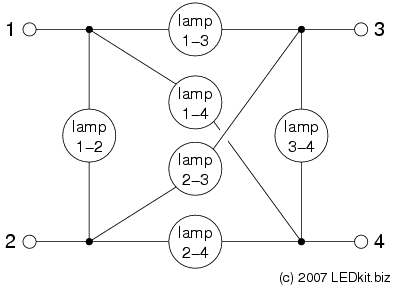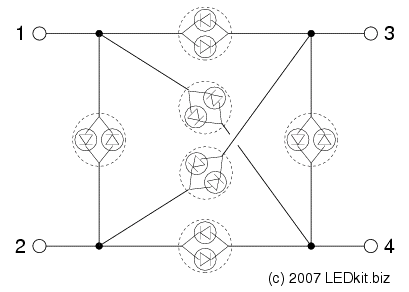
| make your own clock |  |
kits $27-35 |
| in the news | contact us | includes all materials | |
| testimonials | scalability | principles |
LEDkit™ clock kits use tristate multiplexing in order to minimize the number of wires that need to be connected from the driver to the display panel. With tristate multiplexing, 30 different LED segments can be independently controlled using only six wires.
Tristate multiplexing differs from ordinary multiplexing because it uses a different property of the lamp element. While ordinary multiplexing relies just on the LED's ability to block reverse current, tristate multiplexing uses the element's forward voltage characteristics — the fact that small voltages do not light the lamp as much (or at all — in the case of LEDs — see below).
What this means is that you can connect a lamp to each possible pair of wires without worrying about interference. For example, we can attach six lamps to four control wires as shown below:

Applying a voltage across terminals 1 and 2 lights lamp 1-2. It does not light lamps 1-3, 2-3, or 3-4 because none of those lamps get the full voltage.
In this example you can control 6 lamps using 4 wires. Normal multiplexing would give you only 4 lamps.
In general, tristate multiplexing with n wires gives you n * (n-1) / 2 lamps because that is how many pairs of wires there are.
In any multiplexing scheme, multiple segments appear to be illuminated even though only one is on at a time. The elements to be illuminated are turned on one at a time in rapid repitition to create the illusion that all of them are continuously on. Contrary to popular belief, refresh rates higher than 100Hz are needed to maintain this illusion. LEDkit™ clocks use a much higher refresh rate so that the display does not appear flickery when viewed from the corner of the eye or when moving one's eyes.
LEDs and a few other types of lamps have an extreme nonlinearity in their voltage characteristic which causes them to not light at all when there is insufficient voltage. This results in a clean image in your clock because there is no stray illumination from the LEDs themselves.
Finally, LEDs have the reverse-voltage blocking used in traditional multiplexing, allowing twice as many LEDs to be controlled as shown below.

In general, tristate multiplexing with n wires and polarized elements gives you n * (n-1) lamps because that is how many ordered pairs of wires there are.
| discover LEDkit | customize | what you get | get yours now |
| a big, fun project | make any face | clock features | a store near you |
| solderless | advanced mods | kit contents | kits $27-35 |
© 2007 LEDkit. All rights reserved. legal information | contact us